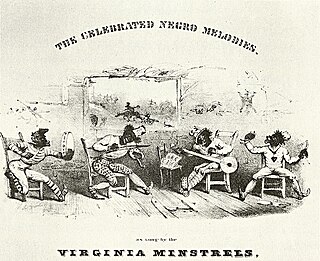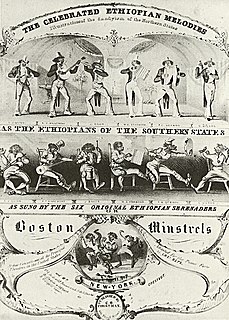
The Black and White Minstrel Show was a British light entertainment show that ran for twenty years on BBC prime-time television. Beginning in 1958, it was a weekly light entertainment and variety show which presented traditional American minstrel and country songs, as well as show tunes and music hall numbers, and with lavish costumes. It was also a popular stage show.

Bamboozled is a 2000 satirical comedy-drama film written and directed by Spike Lee about a modern televised minstrel show featuring black actors donning blackface makeup and the resulting violent fallout from the show's success. It features an ensemble cast including Damon Wayans, Jada Pinkett Smith, Savion Glover, Tommy Davidson, Michael Rapaport and Mos Def.

The Virginia Minstrels or Virginia Serenaders was a group of 19th-century American entertainers who helped invent the entertainment form known as the minstrel show. Led by Dan Emmett, the original lineup consisted of Emmett, Billy Whitlock, Dick Pelham, and Frank Brower.

Daniel Decatur "Dan" Emmett was an American songwriter, entertainer, and founder of the first troupe of the blackface minstrel tradition, the Virginia Minstrels.

Christy's Minstrels, sometimes referred to as the Christy Minstrels, were a blackface group formed by Edwin Pearce Christy, a well-known ballad singer, in 1843, in Buffalo, New York. They were instrumental in the solidification of the minstrel show into a fixed three-act form. The troupe also invented or popularized "the line", the structured grouping that constituted the first act of the standardized three-act minstrel show, with the interlocutor in the middle and "Mr. Tambo" and "Mr. Bones" on the ends.

Thomas Dilward (1840–1902), also known by the stage name Japanese Tommy, was an African-American dwarf who performed in the blackface minstrel show. He was also sometimes billed as "The African 'Tom Thumb'" and the "African Dwarf Tommy".

The Ethiopian Serenaders was a blackface minstrel troupe from the 1840s. Their first major performance was for John Tyler at the White House in 1844 as part of the "Especial Amusement of the President of the United States, His Family and Friends". After this success, the troupe altered its act to make it more "refined" and to appeal to a higher-class audience than had traditionally patronized blackface entertainment. They billed their shows as blackface "concerts" and added songs of a sentimental, romantic nature, even going so far as to perform pieces from popular operas. In exchange, they cut bawdy, humorous material like that used by the Virginia Minstrels and other troupes.
Madame Rentz's Female Minstrels was a blackface minstrel troupe composed completely of women. M. B. Leavitt founded the company in 1870. Unlike mainstream minstrelsy at the time, Leavitt's cast was entirely made up of women, whose primary role was to showcase their scantily clad bodies and tights, not the traditional role of comedy routines or song and dance numbers. The women still performed a basic minstrel show, but they added new pieces that titillated the audience. John E. Henshaw, who began his career as a stage hand with Madame Rentz's Female Minstrels, recalled,

Primrose and West was the name of a blackface song-and-dance team made up of partners George Primrose and William H. "Billy" West. They later went into the business of minstrel troupe ownership with a refined, high-class approach that signaled the final stage in the development of minstrelsy as a distinct form of entertainment.
Bryant's Minstrels was a blackface minstrel troupe that performed in the mid-19th century, primarily in New York City. The troupe was led by the O'Neill brothers from upstate New York, who took the stage name Bryant.

William M. "Billy" Whitlock (1813–1878) was an American blackface performer. He began his career in entertainment doing blackface banjo routines in circuses and dime shows, and by 1843, he was well known in New York City. He is best known for his role in forming the original minstrel troupe, the Virginia Minstrels.
The stump speech was a comic monologue from blackface minstrelsy. A typical stump speech consisted of malapropisms, nonsense sentences, and puns delivered in a parodied version of Black Vernacular English. The stump speaker wore blackface makeup and moved about like a clown. Topics varied from pure nonsense to parodies of politics, science, and social issues. Although both the topic itself and the black character's inability to comprehend it served as sources of comedy, minstrels used such speeches to deliver social commentary that might be considered taboo in another setting. The stump speech was an important precursor to modern stand-up comedy.
"Ole Bull and Old Dan Tucker" is a traditional American song. Several different versions are known, the earliest published in 1844 by the Boston-based Charles Keith company. The song's lyrics tell of the rivalry and contest of skill between Ole Bull and Dan Tucker. The song also satirizes the low pay earned by early minstrel performers: "Ole Bull come to town one day [and] got five hundred for to play."
"Miss Lucy Long", also known as "Lucy Long" and other variants, is an American song that was popularized in the blackface minstrel show. A comic banjo tune, the lyrics, written in exaggerated Black Vernacular English, tell of the courtship or marriage of the male singer and the title character. The song is highly misogynistic; the male character dominates Lucy and continues his sexually promiscuous lifestyle despite his relationship with her. "Miss Lucy Long" thus satirizes black concepts of beauty and courtship and American views of marriage in general.
Francis "Frank" Marion Brower was an American blackface performer active in the mid-19th century. Brower began performing blackface song-and-dance acts in circuses and variety shows when he was 13. He eventually introduced the bones to his act, helping to popularize it as a blackface instrument. Brower teamed with various other performers, forming his longest association with banjoist Dan Emmett beginning in 1841. Brower earned a reputation as a gifted dancer. In 1842, Brower and Emmett moved to New York City. They were out of work by January 1843, when they teamed up with Billy Whitlock and Richard Pelham to form the Virginia Minstrels. The group was the first to perform a full minstrel show as a complete evening's entertainment. Brower pioneered the role of the endman.

John Diamond, aka Jack or Johnny, was an Irish-American dancer and blackface minstrel performer. Diamond entered show business at age 17 and soon came to the attention of circus promoter P. T. Barnum. In less than a year, Diamond and Barnum had a falling-out, and Diamond left to perform with other blackface performers. Diamond's dance style merged elements of English, Irish, and African dance. For the most part, he performed in blackface and sang popular minstrel tunes or accompanied a singer or instrumentalist. Diamond's movements emphasized lower-body movements and rapid footwork with little movement above the waist.
George H. Coes was an American minstrel music performer. He appeared in numerous minstrel shows in California and throughout the Northeastern United States.
Day, Charles (1996). "Fun in Black". Inside the Minstrel Mask: Readings in Nineteenth-Century Blackface Minstrelsy. Hanover, New Hampshire: Wesleyan University Press.










